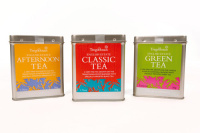Long-distance runs
Working with overseas printers can be just the way to achieve that special quality and make your publication stand out – though there are some drawbacks too. Yolanda Zappaterra investigates
Since the advent of desktop publishing and the Internet more than a decade ago, people from all walks of publishing have been lamenting the imminent death of print. And each year since, printed matter is published that’s more innovative and experimental than ever. Driven by the desire to offer printed projects as beautiful objects rather than just vehicles for content, publishers, designers and printers are working harder than ever to deliver printed matter that is making the sector more exciting than ever, through projects that stand out for their excellence and innovation.
One such piece is Rizzoli’s recent monograph of designer Tord Boontje, designed by Graphic Thought Facility. This lovely book features a cover treatment using mull, the material bookbinders put down the back of a book’s spine to strengthen its binding. GTF creative director Paul Neale says it ‘reflects Boontje’s use of mass-manufacturing and hand-crafting techniques, and adds an unusual dimension to the cover, one intended to create richness rather than novelty’.
Inside the book, readers will find a very high quality of design and production, whose pièce de résistance is the perforated motifs decorating the text pages. ‘It’s a device rooted in Boontje’s blown-glass work. I had a hunch we could adapt the die-stamping process to create something similar, so set about experimenting to see if it was possible,’ explains Neale. Such experimentation is an important part of working well with a printer, he believes. ‘Presenting non-standard ideas is all well and good, but you have to know that they’re viable, so it’s important to establish their possibility before going too far,’ he says.
His route took him via a die-stamper and test printer in the UK to Elegance Printing & Book Binding Co in Hong Kong, where he was impressed with the discipline and work ethic. ‘There must have been production issues to overcome, but we weren’t aware of them. They simply worked to find a way of delivering what we wanted,’ he says. Neale has found that printing outside the UK presents no special problems. ‘But working remotely means you have to be very specific when writing instructions,’ he advises.
Paul Draper, head of design at Bisque Radiators, also prints abroad, working closely with Italian printer Graphicom on Bisque’s sumptuous catalogues. He has found them to be ‘fantastically accommodating, even on huge print runs, allowing us to make mistakes and miss our deadlines and still meet their deadlines so that the publication comes out when it’s supposed to. There’s a high level of expertise and competence, which means potential problems get flagged up, and mistakes dealt with quickly and efficiently,’ he enthuses. For Bisque, the quality of the catalogue is vitally important. ‘For our last one, we built 40 sets over two years to show off the products at their best, so the printing of the catalogue had to reflect that,’ explains Draper. Graphicom offered the best price at the quality that he – and, crucially, his ‘repro genius’, John Bodkin from Dawkins Colour – were looking for. ‘John came with me to Italy to proof the pages,’ he recalls. ‘People don’t give repro the level of importance it deserves, but if the repro’s not good enough, the printing quality won’t be good enough,’ he points out.
Print quality is something that Ralf Herms, editor and publisher of Rosebud magazine (distributed in the UK by DGV), is very aware of. As the publisher of a design magazine ‘committed to continually innovating and experimenting with the concept, structure and possibilities of print and paper’, he has to source the best possible print and production people in Europe. ‘According to the specifications for each issue (which is usually wildly divergent from its predecessor), we look for the best people for that job. For example, our fourth issue was printed in Germany and bound in Switzerland, with the “thumb-punch” produced elsewhere in Germany,’ he explains.
Rosebud has featured issues with open spines, gold-embossed fake leather covers, the world’s first ‘scratch-off ads’, and the aforementioned thumb-punch. ‘Many of the production techniques are non-standard, so we absolutely need printers interested in experimenting,’ says Herms, ‘and while paper qualities are improving, CTP technology is improving quality and efficiency, and more new stuff in the finishing sector is allowing more inventive finishing solutions. At the end of the day it all comes down to the people behind the tools. A good printer still plays the major part in terms of having brilliant or average quality coming out of the machine.’
Where the operator is based ultimately doesn’t matter. As Intro found recently with a promotion pack for the Crafts Council, East Sussex-based printer Beacon Press was able to deliver a beautiful job that used various print finishing techniques to showcase the craft of printing: the corporate brochure featured Singer-sewn binding, the projects brochure French folds and the programme has throw-outs. The solid environmental credentials – vegetable-based inks, recycled paper and 84 per cent recyclability – added to the project rather than detracted from it, showing that such issues can enhance existing print offerings.
As Herms says, ‘There’s no knowing how print will develop, but at least the typical “the book is dead” refrain has declined. And it’s still a great medium to work with. At its best, it’s an unpredictable, living material with a high tactile quality. At its worst? It’s an unpredictable, living material, and mistakes can be very expensive.’
-
Post a comment




